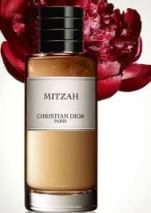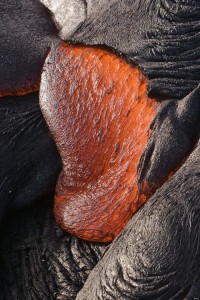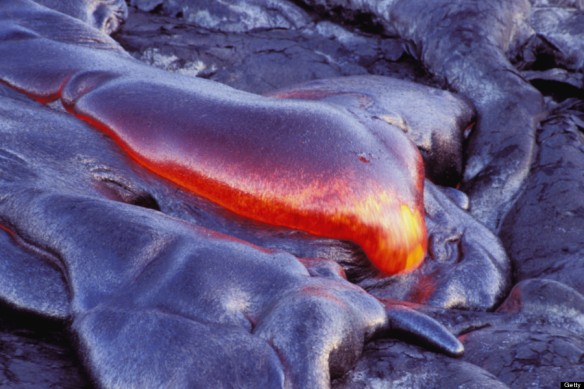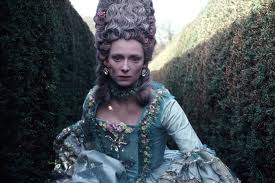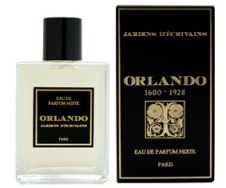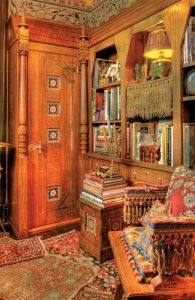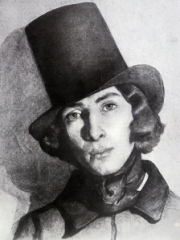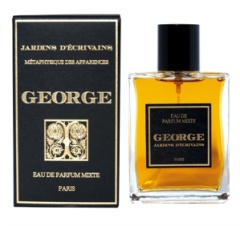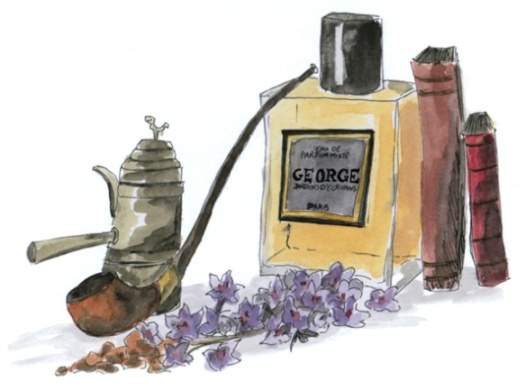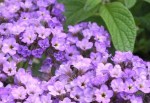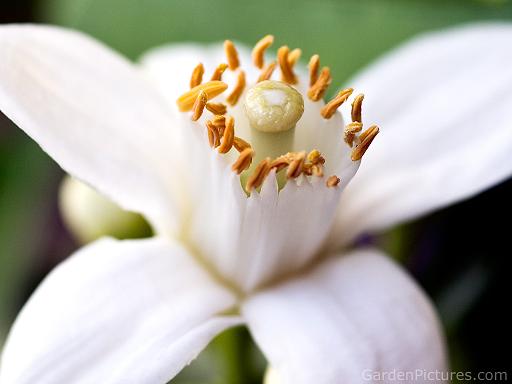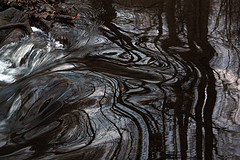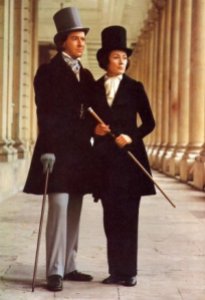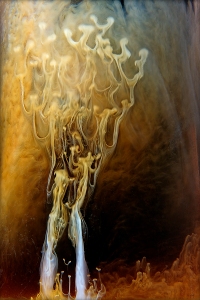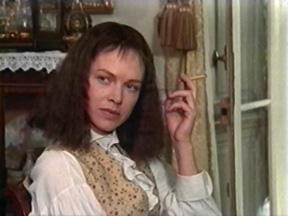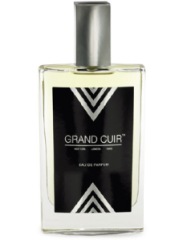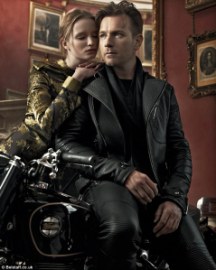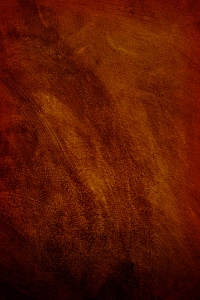Close your eyes, and imagine a river. It’s heavy, swollen with rain, and moving incredibly fast. It would be a “white-water rapids” except this water is thick, dense, chewy, and powerful. It’s not even really water at all, but more like volcanic lava flow; a turgid, toffee thickness of labdanum and patchouli, a mighty force of smoldering, spiced, slightly smoky blacks, browns, and reds that are lightly flecked with bronzed gold. The heady, potent force field of Mitzah-esque labdanum calls you like a siren. You get on a canoe, and shoot forward on the fast-moving, rich, toffee river with incredible speed and power.
Then, suddenly, abruptly, almost impossibly, after less than two hours….. you slooooow to a crawl. The chewy, dense, smoldering river water starts to dry up around you, becoming thinner, lighter, softer. Before you can blink, it’s turned into to a trickle, evaporating around you, until you’re left stranded in the middle of a dry, leathery riverbed with only the smallest pool of amber around you. A pool so sheer and so soft that you’re almost convinced it’s not actually there, and are completely shocked when you detect faint traces of it every hour when you check.
As time passes, the disbelief grows at the severity of the contrasts, and by the mere fact that this seemingly invisible drop of water actually still remains. As night falls, there is no more amber and you are alone with only by the faintest whiff of animalic leather. Then, even that remaining puddle of water vanishes, and you’re left longing for the mighty river that began your journey so many hours earlier.
 That story is the nutshell tale of my journey with the brand-new release from Téo Cabanel Parfums. When a small, hugely under-appreciated, relatively unknown perfume house makes one of your favorite fragrances in the world, you tend to root for it, and want to love all its creations. If the house comes with a fascinating history — complete with the notorious style icon, the Duchess of Windsor, as its most ardent fan — and if you’re a history fanatic, then you are even more compelled to want to like it. The reality, however, is that not all perfumes are created equal. And some fall short of the glory set by their siblings. That is the case with Barkhane, a lovely fragrance from the same house that created my beloved Alahine, but hardly a match for the latter’s potent, fierce, boozy, and utterly spectacular, sophisticated, spicy smolder.
That story is the nutshell tale of my journey with the brand-new release from Téo Cabanel Parfums. When a small, hugely under-appreciated, relatively unknown perfume house makes one of your favorite fragrances in the world, you tend to root for it, and want to love all its creations. If the house comes with a fascinating history — complete with the notorious style icon, the Duchess of Windsor, as its most ardent fan — and if you’re a history fanatic, then you are even more compelled to want to like it. The reality, however, is that not all perfumes are created equal. And some fall short of the glory set by their siblings. That is the case with Barkhane, a lovely fragrance from the same house that created my beloved Alahine, but hardly a match for the latter’s potent, fierce, boozy, and utterly spectacular, sophisticated, spicy smolder.
Barkhane is an eau de parfum from the French perfume house, Téo Cabanel. It is a very old brand that was founded in 1893 in Algeria by Théodore Cabanel, a talented, very prolific perfumer who moved to Paris in 1908 where he developed well over 150 different perfume formulae. He fast came to the attention of high society, and became a favorite of the Duchess of Windsor — the woman for whom King Edward VIII famously gave up the British throne. In fact, she refused to be without two of Cabanel’s fragrances (Julia and Yasmina), ordering bottles in massive quantities, and Cabanel became her official perfumer.
Unfortunately, over time, the house faded away, but it was essentially reborn in 2003 under the direction of Caroline Illacqua who had a distant connection to Cabanel’s daughter. Illacqua brought in the perfumer, Jean-Francois Latty, a very famous “nose” who created YSL for Men, YSL‘s Jazz, Givenchy III, Van Cleef & Arpel‘s Tsar and, allegedly, Drakkar Noir as well. (If so, I assume he worked alongside Pierre Wargnye who is usually credited with that famous men’s cologne). Latty now works solely as the in-house perfumer for Téo Cabanel.
This week, the two released Barkhane, an eau de parfum that is the first of the Cabanel line to include oud. The company describes the perfume (and explains its name) as follows:
Rich, warm and mysterious, Barkhane borrows its name from the smooth, velvety dunes which gently ripple under powerful desert winds. Barkhane owes its refined elegance to the very finest ingredients. All at once powerful and subtle, it develops its own fascinating uniqueness.
The press release documents describe the fragrance as a “woody-chypre,” which I find quite odd as Barkhane has the most oriental notes and smell imaginable. According to the description on Téo Cabanel’s website and on Fragrantica, Barkhane’s notes include:
bergamot, labdanum, Indonesian patchouli, geranium, cumin, curry tree, vetiver, oud, myrrh, tonka bean, vanilla and musk.
I sprayed Barkhane on my skin, and my response was instantaneous: I actually cried out aloud, “Mitzah!” Then, I sniffed the vial, sniffed my skin again, and almost did a happy dance. The first line on my note pad is: “Mitzah, Mitzah, Mitzah!” For those of you unaware of the name, Mitzah is one of Dior‘s elite Privée line of fragrances and a huge cult hit with a very passionate following. Or, rather, I should say, it was, since the imbeciles at Dior suddenly decided to discontinue it for reasons that no sane person (including people who work at Dior) can fathom. Mitzah is one of my favorite perfumes, still available at some Dior boutiques and Dior online, but the remaining stock won’t last forever, and one day, it will be nothing more than a ridiculously priced hot commodity on eBay. So, as you can imagine, I was thrilled that there may be an alternative out there should my giant bottle ever dry up.
Barkhane opens like Mitzah on steroids. No two ways about it. It has some of Alahine’s explosive, nuclear opening, but with the Mitzah aroma. Could there really be greater joy? When you sniff the vial, it’s all roses and labdanum, but the opening burst on the skin is purely the labdanum. It feels like a tidal wave of brown, nutty, leathery, sweet toffee with an almost caramelized undertone and richness. It’s immediately followed by incense smoke, and dark, chewy, spiced, real patchouli.
Then, the spices appear. There is a heaping teaspoon of sweetened curry, with just the merest dash of dry, dusty cumin. There is nothing sweaty about the mixture, and absolutely no trace of body odor. It also doesn’t smell like food or actual Indian curry dishes. The spices are blended seamlessly into Barkhane, never feeling very noticeable in a heavy, distinctive way, and really smelling more like the dry dustiness surrounding a spice merchant in a Moroccan souk or bazaar. Even if they weren’t so well-blended in the fragrance, the simple fact is that there is little that could possibly trump that powerful wave of labdanum toffee and slightly smoky patchouli.
Other notes flit about Barkhane’s edges. There is a bitter citrus note like the slightly sour peel of a lemon rind that has been dried. A subtle hint of woody, equally dried vetiver pops up in tiny doses. Underneath the heavy top notes, there are also subtle flecks of geranium’s greenness, some golden musk, and a sliver of vanilla. The geranium is the most interesting thing to me because, at first sniff on the skin, Barkhane differs from Mitzah in not having that undercurrent of rose. But it is the oddest thing: if you smell the vial, you definitely smell roses under the labdanum amber. And, on the skin, the same thing slowly starts to appear. It has to be the geranium whose flowers can often have a spicy, rose-adjacent, rich red smell. In short, something about the combination of the geranium and the patchouli seems to have recreated the aroma of deep, ruby-red roses in Barkhane, thereby completing the similarity to Mitzah.
Even if I didn’t know and love Mitzah, I would adore Barkhane’s opening. It’s a chewy, spicy, smoky fragrance that is absolutely stunning. The sweetness is perfectly balanced by the dry spices and the suggestion of woodiness. Speaking of which, to my nose, there is absolutely no “oud” that ever appears in Barkhane. There is a definite dry woodiness underlying the fragrance, but it’s wholly amorphous and lacking in distinction to me. It’s probably the subtlest part of the fragrance as a whole, because Barkhane’s real source of dryness are the spices and incense.
At first, Barkhane is massively potent. In that way, it is like all the Téo Cabanel fragrances that I’ve tried thus far (Alahine & Oha), but it’s not quite as ferocious as Alahine can be. That is a fragrance that is much better with less, especially as a heavy application can completely and utterly blow out your nose at first sniff. (It did to me the very first time I tried it.) To give you an idea of the potency of some Cabanel fragrances, my parents each applied a small dab of Alahine in solid form, and I could smell them almost across the whole length of the house. And even up a flight! (Alahine is unisex, by the way, and found an immediate fan in my father.) Barkhane doesn’t quite pack the same nuclear punch as Alahine in its opening minutes, but it certainly tries. And it’s definitely much more powerful than Mitzah at the start.
 Thirty minutes in, Barkhane unfurls and blooms into the loveliest, deep, dark labdanum amber with a floral undertone. It really smells like that heady, powerful, concentrated, dark rose note that Téo Cabanel loves so much and which is probably their signature. The curry note is also starting to become more prominent. It is dusty, evoking an old apothecary’s cabinet from centuries past, a cabinet whose wooden drawers carry the lingering traces of spice and time. The patchouli continues to be forceful, and the smoke seems to have increased, adding yet another subtle dose of dryness to the nutty, slightly dirty, very toffee-smelling amber.
Thirty minutes in, Barkhane unfurls and blooms into the loveliest, deep, dark labdanum amber with a floral undertone. It really smells like that heady, powerful, concentrated, dark rose note that Téo Cabanel loves so much and which is probably their signature. The curry note is also starting to become more prominent. It is dusty, evoking an old apothecary’s cabinet from centuries past, a cabinet whose wooden drawers carry the lingering traces of spice and time. The patchouli continues to be forceful, and the smoke seems to have increased, adding yet another subtle dose of dryness to the nutty, slightly dirty, very toffee-smelling amber.
50 minutes in, Barkhane starts to change in weight, texture, and feel. It becomes softer, tamer, milder, dropping quickly in its heaviness, projection, and power. Now, it hovers only 3 inches above the skin, a fact that should tell you something about its opening minutes. While that is still very strong, the more significant fact is that Barkhane feels much thinner than it did at its start. It’s now more like darkened silk, rather than an opaque river of black, viscous, dense resin. The perfume continues to turn more sheer — and, then, suddenly, it drops like the wind.
Ninety minutes into its development, Barkhane is suddenly a skin scent. From a powerful Saharan sandstorm, it’s become a veritable puff of air — and it’s a shockingly fast transformation. Barkhane is now the sheerest glaze of dark, toffee’d labdanum, infused with patchouli, spices and incense. It feels amorphous, intangible, elusive, and likely to slip away at any moment. What happened?! Every 20 minutes, I sniff my arm in the expectation that Barkhane has completely vanished. My nose is right on the skin, and, at times, I have to practically inhale to detect anything beyond the amber, but it didn’t die. My notes are filled with time calculations, and the disbelieving words: “still there.” By the end of the 3rd hour, I wrote “almost all gone.” I was utterly mystified. To have that degree of drastic change is not something I’ve experienced often.

Photo: Heather A. Riggs, available at her Etsy store, ShyPhotog. (Direct website link embedded within photo.)
Even more bewildering is the fact that Barkhane seems to have come back to life, albeit in the sheerest, most translucent manner imaginable. Hour after hour, it hung on as a labdanum-patchouli-incense fragrance. To my complete disbelief, Barkhane actually seemed to get stronger around the start of the 8th hour!! It was still a skin scent, but easier to detect. I’ve never been anosmic to amber, especially not to labdanum, so I can’t explain it, but I’m currently at the end of a second full test and the same situation is unfolding. Crazily enough, Barkhane lasted just over 11.75 hours on me. In its final hour, it turned completely leathery with an animalic, musky edge that almost bordered on the subtly urinous, but not quite. The amber warmth remained, adding a faint glow of warmth, but Barkhane was primarily a nebulous, vague, dry, animalic leather fragrance that lingered in gauzy patches that were scattered across the skin.
In the end, Barkhane’s long duration is consistent with the other Téo Cabanel fragrances that I’ve tried, but the sillage issue is quite new to me. I was really convinced that Barkhane was about to die at the end of the third hour! Making matters more bewildering is that I had actually sprayed quite a lot of Barkhane, at least by my particular Téo Cabanel standards: 3 sprays that were very big and full-sized due to the large nozzle. For this generally intense line of fragrances, that is a lot for a starting test! (Do not ever try that with Alahine, for example, at least until you get used to it.) In my second test, I used 4 and 1/2 large sprays, but the situation followed the same path with only a fractional increase in the time that it took Barkhane to turn to gauze.
Barkhane is too new for there to be reviews out in the blogosphere, but I went to Fragrantica in hopes that someone may have shared their experience there. They haven’t, but I was relieved to see some early votes in the longevity and sillage sections:
- One person gave Barkhane the lowest longevity rating which is “Weak,” and which is defined as “1h – 2h.” However, two people chose “long lasting” which is defined as “7h – 12h.”
- For projection, 2 people gave it the lowest rating at “Soft,” while one person chose “Moderate.”
I need to make something clear: sillage is a personal preference. Some people don’t want fragrances that howl at the moon, and that’s fine. Mitzah has discreet sillage, too, but the difference is that Mitzah becomes unobtrusive after about 5 or 6 hours! The comparative difference with Barkhane — and the speed of the changes in so many areas as weight, feel, and projection — can’t be ignored. More to the point, when it feels almost certain that a fragrance is about to die after a mere 3 hours, then it has to be discussed, regardless of what the end result is or one’s personal tastes. Judging by the very early Fragrantica votes, there is clearly someone out there for whom Barkhane didn’t die at the end of the 3rd hour, but even sooner and after a mere 1-2 hours. I have to wonder if sillage played a role in that result; if a perfume’s projection seems virtually nonexistent at times, then people who can’t sniff voraciously at their arm every 20 minutes may well conclude that their perfume has vanished.
On the other hand, early votes also demonstrate that Barkhane had great longevity on some people — and it does. So, if you’re looking for something like Mitzah that is even more discreet and intimate, then you’ve got to try Barkhane. In the ways that perhaps matter most, it’s a knock-out. It’s a sophisticated amber that has been done with great finesse and, as always with Téo Cabanel, with extremely high-quality ingredients.
All in all, only one thing stops Barkhane from getting high ratings across the board. Ignoring that one (significant) issue, Barkhane is really lovely: a heady, sweet, spicy, smoky, slightly leathery, nutty and toffee’d amber with lovely decorative flourishes in an incredibly chic, smooth, seamless, refined bouquet. It’s sexy, and seductive in its dark, smoldering glow, but also comforting in its warmth and softness. It would work well on all genders, and it would be perfect for a very conservative office environment (although I would still be careful with the quantity that you apply, given the potency of Barkhane’s first hour). If you’re not looking for the mighty Saharan wind, but the lightest, sheerest, most intimate whisper of darkened amber, then you should definitely try Barkhane.
DISCLOSURE: My sample of Barkhane was courtesy of Hypoluxe. That did not influence this review. I do not do paid reviews, my views are my own, and my first obligation is honesty to my readers.
DETAILS:
Cost & Availability: Barkhane is an eau de parfum that comes in a 50 ml/1.7 oz size that costs $130 or €95. It is also available in a 100 ml/3.4 oz size that isn’t quite as common and which costs €120. You can order Barkhane directly from the Téo Cabanel website (which also has a French language version), along with a Sample Set of all 7 Cabanel fragrances in 1.5 ml vials for a set price of €8.50.
In the U.S.: you can order Barkhane in the 50 ml size (at $130) from Luckyscent which now carries a number of the Téo Cabanel line, including my beloved Alahine. (I should add, however, that the latter is also available from discount retailers for a cheaper price, and you can check the Alahine review for some old links.) Luckyscent also offers samples starting at $4 a vial for 0.7 ml. (It’s a much better deal ordering directly from the company!)
Outside the US: In Canada, Cabanel’s website lists Fritsch Fragrances as its primary vendor. In the UK, London’s Bloom Parfumery carries some Téo Cabanel, but not all. You can call or email to see if they will carry Barkhane once it releases in the UK. Elsewhere, Téo Cabanel is usually carried at Fortnum & Mason’s, but I don’t see it shown online. Liberty’s states that Téo Cabanel fragrances are available only in their actual store. The Téo Cabanel line is carried at Germany’s First in Fragrance, but Barkhane is too new to be shown on the website yet. There are a vast number of perfume shops in the Netherlands and Germany which carry the Teo Cabanel line, so you can check the company’s website link for retailers that is provided down below. As a whole, for European readers, I saw Téo Cabanel online at Parfums MDP (which I think is in the UK?) for the same Euro rate as the company’s website. They say that there is “free worldwide postage” which I find to be stunning (and hard to believe)! I’ve also read that the perfumes are available at: the Hotel George V in Paris, Les Galeries Lafayette, Douglas (France, Lithuania, Russia), Kadewe Berlin, Oberpollinger Munich, and Albrecht in Frankfurt. For all other countries or specific cities, you can use the company’s Store Locator guide on their website.
Samples: Barkhane is available to test at Luckyscent, at the link above. It is too new for it to be carried at other places, but I will try to update this post if someone other than Luckyscent offers samples. Your best bet for the next few months is the latter, or the Téo Cabanel website with their very affordable sample set.





